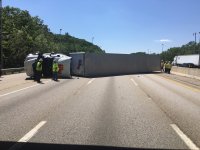Air brakes have nothing to do with safety chains on semi's. As mentioned before, it is the strength of the kingpin and properly adjusted fifth wheel jaws. If you ever watched Highway from **** when they were trying to disconnect a tractor and trailer in a bad way, that connection can be tough to seperate. Real life and not some TV show, that is exactly how it is.
If you saw a trailer seperate it was because as I said the fifth wheel jaws were not properly adjusted and/or the driver never crawled under the trailer and looked to see if it was properly secured. In addition to that, the driver still needs to test that connection.
FWIW, the tow dollys or jiffster's on a set of doubles do have safety chains that need to be connected to the lead pup. That is in addition to really heavy duty pintle hitches. The tow dolly of course has a fifth wheel so now the driver needs to crawl under two trailers. When I ran doubles, I did see them dropped on occasion. Some of the dolly configurations were shall we say seemed to be more prone (the ones with a high saddle for those of you whom have had the pleasure) so you had to be extra careful. I always did a figure eight in the lot before I ever pulled onto the main road. Trust me, making and breaking four sets a night gets old.
There are a couple of negatives with goosenecks. Though more of an issue with an older tow vehicle as in a lot less torque is that they do pull a little heavier. If you can, before you pull the trigger, hook the trailer up and see how it handles. Some combinations will cause "cab slap". That is a motion where as the seat back seems to be nudging you sometimes pretty roughly. On a dovetail or a beaver tail, watch the clearance between the rear frame and the road. Depending on your area of operation, you could be dragging a bit. Lastly, don't be jacking that trailer around anymore or faster than necessary. You can roll the tires right off of the rims.


